Cultural identity, terrain, traditions, body types, beliefs. How many other markers reveal how we like to move, how we define dance? Two very dissimilar styles appeared last week some miles north of New York City in pastoral surroundings. Israel’s Vertigo Dance Company performed in Jacob’s Pillow’s Ted Shawn Theater July 4 through 8, and on July 6, France’s Compagnie Fêtes galantes opened Bard’s Summerscape 2012 (which runs through August 19) with three performances.
If Mana (2009) is typical of the pieces in Vertigo’s repertory, choreographer Noa Wertheimer and her co-artistic director Adi Sha’al, who founded the company together ten years ago, are interested in turbulence, unsteady ground, dizziness—all that might threaten equilibrium. But the ten powerful dancers in Mana do not yield to any such conditions—or if they do, they rebound, or respond by attacking the air or the floor. Vertigo is named after an early duet that Wertheimer and Sha’al created for themselves; its title derives from feelings Sha’al experienced during his training in the Israeli air force. But it might as easily be construed as expressing the unstable political terrain of Israel.
“Mana,” can be translated as “vessel of light.” The concept comes from The Zohar, one of the mystical texts connected with Kabbalah. The Jacob’s Pillow program contains a long note about dualities, ending with these sentences: “Mana is an ontological postmodern contemplation of the essence of dance and existence. Is it indeed possible, in a world of light and darkness, black and white, yin and yang, to grasp what cannot be grasped?” I wish I hadn’t read this. What dance could express these immense ideas?
What Wertheim has created is the picture of a community of people who are fervent and fiercely energetic; they’re grounded, but aspire to shoot upward. Their struggles, their collaborations, their moments of unity seem more part of an ongoing pattern than a journey progressing to fulfillment. At one point, Rina Wertheim-Koren appears, walking on tiptoe, with a large, black balloon attached to her shoulders; whatever the intended metaphor, it’s mixed. Is the balloon lifting her up, or is it a dark cloud under which she must travel? At the end, she reappears with the balloon less tethered, and the dancers gaze at it as if it signified release.
Mana is accompanied by a very interesting score by Ran Bagno that utilizes mostly struck and plucked instruments, along with voices and electronic effects. Rakafet Levy-School of Theatrical Design created both set and costumes. At the back of the stage stands what looks like the plain, flat front of a very wide house with a very broad handleless door at its center. (Imagine the typical boxy, peak-roofed house a first-grader might draw and now imagine a very heavy something has pressed down on it.) The heavy garments— intricately cut and draped from dark fabric—might have been cobbled together by members of some long-ago Gnostic sect. The jackets can be loosened and pushed down around the waist. The only color comes from headscarves the women dancers wear at the outset.
The costumes and décor, plus Dani Fishof-Magenta’s lighting, abet the atmosphere of shifting terrain. The “door” slides unobtrusively backward or forward to create entryways and exits and block them up again. The surrounding “house” too can travel, increasing or decreasing the available space. As the dancers hurtle about the stage, their costumes create little tornados around them.
The piece begins with an impressive solo by Micah Amos, who thrusts his arms and body into the surrounding space, curls his hands into fists. Tomer Navot sits facing away from the audience, like an acolyte waiting for his mentor to lay down the precepts. When he rises and joins Amos, the two negotiate complicated, off-balance supports. Several times, Amos grabs Navot by the hand and, turning him, launches him into an immense jump.
There are moments in Mana when the dancers step lightly or form couples for a sort of folk dance, but mostly their movements are big and weighted. You rarely notice their feet. They use the entire body as an explosive unit—suddenly bursting into astonishingly high leaps, dropping to the floor, rolling, and recovering to hurl themselves around some more. Sometimes they move in unison squads, tight in space, sometimes in more diverse encounters. In a powerful duet for Nitsan Margaliot and Eyal Vizner, Vizner’s repeated backward collapses into Margaliot’s arms turn into an acrobatic display of spatial dislocation. One of the most interesting sections is a quartet for Ruth Valensi, Vizner, Amos, and Navot that embraces a touch of diversity, a sense of individual and collective desires.
The “house” offers only symbolic containment. Mana evokes a rural village, its members pounding the possibly fertile ground as they investigate the possibly spiritual air.
In the Sosnoff Theater of Bard’s Richard B. Fisher Center, members of Compagnie Fêtes Galantes navigate a very different environment—one in which footwork is very important, and turbulence is kept at bay. This too is a group of ten. It’s under the direction of Béatrice Massin, whose background is in Baroque dance (she performed with Ris & Danceries, the company run by Francine Lancelot, who choreographed William Christie’s production of the Lully opera Atys). Although the term “fêtes galantes” refers to post-Louis XIV gatherings of aristocrats that could take place in parks as well as ballrooms, Massin’s choreography for Let My Joy Remain (Que ma joie demeure) emphasizes the light stepping and the aristocratic bearing that suggest courtly negotiations on a polished floor.
Massin is not presenting authentic Baroque dances; she’s using the style as a base on which to expand—preserving its buoyancy, its little flourishes of arm and wrist, and its sense of traveling within a prescribed space. In France, Compagnie Fêtes galantes includes a musical ensemble. At Bard it performed to recordings of Bach’s Brandenburg concerti numbers 2, 3, and 6 by the Amsterdam Baroque Orchestra, led by Ton Koopman, as well as to a recording by La Chapelle Royale, Philippe Herreweghe conducting, of the gorgeous duet for soprano and alto from Bach’s cantata BWV 78, Jesu, der du meine seele (sung, I believe, by Ingrid Schithusen and Charles Brett). There are also considerable plots of silence between the musical gardens.
The dancers all wear shoes with slight heels; loose-legged pants, trimmer at the ankle; and tight-waisted coats in modified 18th-century style that reach halfway to their knees. The colors of the coats are mostly shades of red, with one pink and and several yellow ones (costumes by Dominique Fabregue). For reasons not entirely clear, the slightly raised floor is red, and in the sections danced in silence, Rémis Nicolas’s lighting turns everything disconcertingly red.
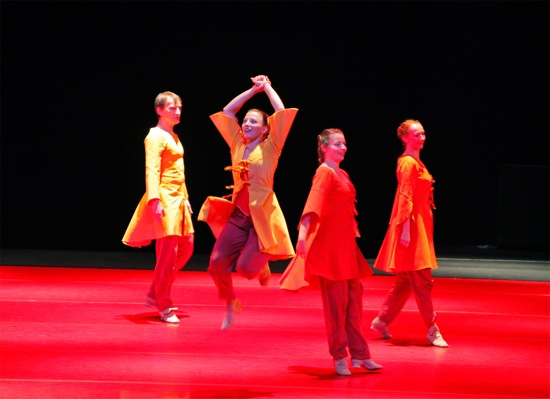
L to R: David Berring, Laura Brembilla, Sarah Berring, and Gudrun Skamletz in Let My Joy Remain. Photo: Cory Weaver
Massin’s concept is simply to adventure with the rhythms and patterns of Bach’s music. The dancers assemble gradually while the aria is sung, and gather to watch from the sidelines while one couple, then another tries out some gracious steps.
Once the Brandenburgs begin, the pace increases. There’s a lot of travelling in Let My Joy Remain. The dancers skim the stage with swift rising and sinking steps; they’re often in clusters, with various individuals joining or dropping out. Turns and springy, unstressed leaps begin to amplify the patterns In one allegro passage, a little stamp of a foot punctuates the musical phrase. Nothing looks effortful. David Berring dances a solo that shows off his strength, while maintaining the nonchalant airiness that’s part of Baroque style.
Small encounters ensue, but there’s very little touching; it’s a surprise when a woman springs into a man’s arms, as if to be carried across a stream. A lovely trio, performed by Laura Brembilla, Laurent Crespon, and Berring to an andante passage, is an exception. Gradually the movement becomes more unbuttoned, both literally and temperamentally. Jackets begin to come off, revealing corset-like vests or tee shirts. People shed their shoes, some their trousers.
Adeline Lerme walks to the front of the stage and her knees start shaking uncontrollably, Olivier Collin comes up behind her and she, twitching, moves away from him; he steps quickly behind her again—whether to control her or join her. A threesome off to the side (Brembilla, Damien Dreux, and Gudrun Skamletz) experience similar lapses in control; perhaps they’re shaking off decorum. Although there are still calm moments, by the time the final allegro of the 6th Brandenburg starts (bypassing the music’s adagio), these happy people are cartwheeling or rolling on the floor, hopping, leaping, and kicking up their heels in permissible disorder.
No stormy weather here. No vertigo. Just enough imbalance to reaffirm the possibility of equilibrium. For Compagnie Fêtes galantes, on a 2012 summer night in Frank Gehry’s postmodern silver building, the French Revolution is both fifty years in the future and two hundred years in the past.

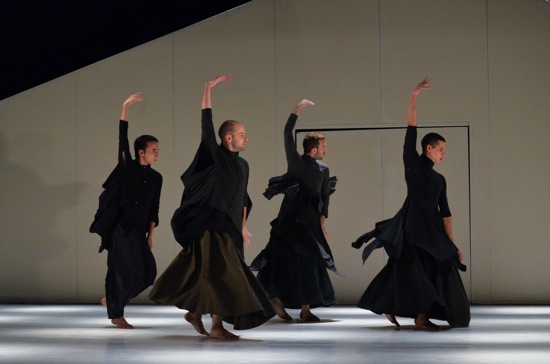
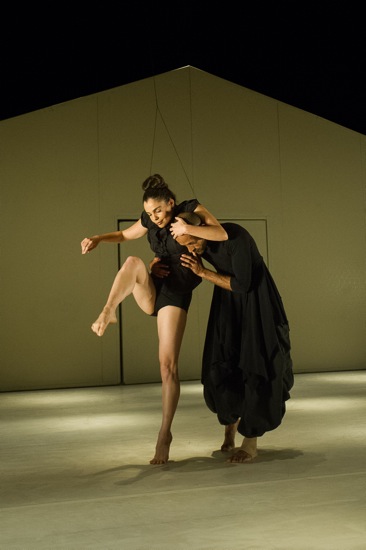
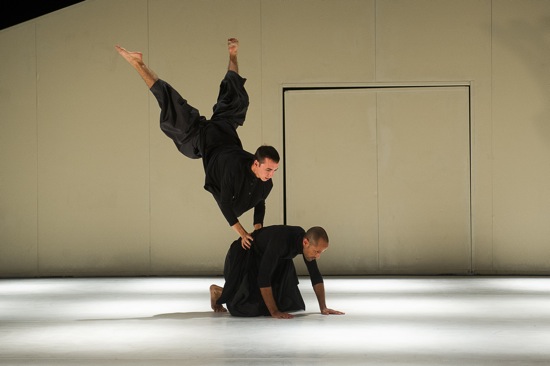
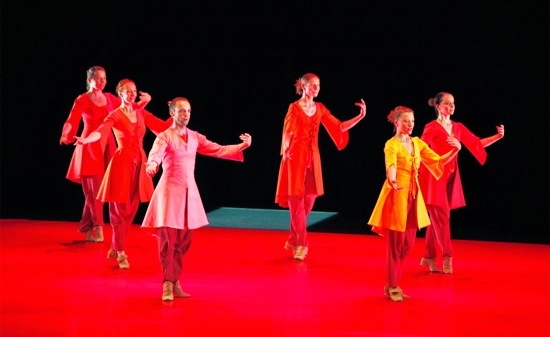
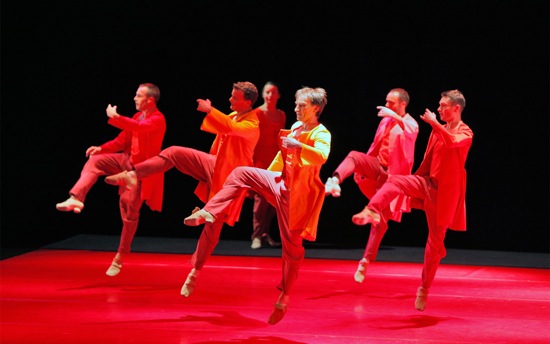
I too wished I’d not read the program notes when I saw Vertigo Dance perform “Mana” in Portland, presented by White Bird. My feeling was that the house represented a kibbutz, not a village, and much of the choreography, particularly the quartet Deborah mentions, the physical and emotional dependency its members have on one another for survival of all kinds. Deborah’s eloquent writing reminded me of my feelings as I witnessed Vertigo Dance, and instilled a fair amount of envy that she got to see Compagnie Fetes, and I did not.